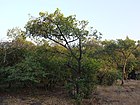Note: This is a project under development. The articles on this wiki are just being initiated and broadly incomplete. You can Help creating new pages.
Difference between revisions of "Carallia brachiata"
(→Photo Gallery) |
|||
| Line 58: | Line 58: | ||
==Photo Gallery== | ==Photo Gallery== | ||
<gallery class="left" caption="" widths="140px" heights="140px"> | <gallery class="left" caption="" widths="140px" heights="140px"> | ||
| − | |||
Antimiriyam (Tamil- அந்திமிரியம்) (6673407445).jpg | Antimiriyam (Tamil- அந்திமிரியம்) (6673407445).jpg | ||
Blue Tiger Moth Caterpillar on Carallia brachiata.jpg | Blue Tiger Moth Caterpillar on Carallia brachiata.jpg | ||
Revision as of 12:22, 9 April 2020
Carallia calycina is an evergreen tree. It can vary considerably in height, reaching 15 metres in locations such as China and Madagascar, but up to 50 metres in the humid forests of southeast Asia. The straight, cylindrical bole can be 25 - 70cm in diameter, occasionally with small buttresses and or aerial roots.
Contents
- 1 Uses
- 2 Parts Used
- 3 Chemical Composition
- 4 Common names
- 5 Properties
- 6 Habit
- 7 Identification
- 8 List of Ayurvedic medicine in which the herb is used
- 9 Where to get the saplings
- 10 Mode of Propagation
- 11 How to plant/cultivate
- 12 Commonly seen growing in areas
- 13 Photo Gallery
- 14 References
- 15 External Links
Uses
Fevers, Smallpox, Septic poisoning, Itch.
Parts Used
Chemical Composition
Common names
| Language | Common name |
|---|---|
| Kannada | |
| Hindi | |
| Malayalam | |
| Tamil | |
| Telugu | |
| Marathi | |
| Gujarathi | |
| Punjabi | |
| Kashmiri | |
| Sanskrit | |
| English |
Properties
Reference: Dravya - Substance, Rasa - Taste, Guna - Qualities, Veerya - Potency, Vipaka - Post-digesion effect, Karma - Pharmacological activity, Prabhava - Therepeutics.
Dravya
Rasa
Guna
Veerya
Vipaka
Karma
Prabhava
Habit
Identification
Leaf
| Kind | Shape | Feature |
|---|---|---|
Flower
| Type | Size | Color and composition | Stamen | More information |
|---|---|---|---|---|
| {{{5}}} |
Fruit
| Type | Size | Mass | Appearance | Seeds | More information |
|---|---|---|---|---|---|
Other features
List of Ayurvedic medicine in which the herb is used
Where to get the saplings
Mode of Propagation
Seeds, Terminal branch cuttings.
How to plant/cultivate
Older plants grow well in an open position, but younger plants are more tolerant of shade and dislike too much sun.[3]
Commonly seen growing in areas
Lowland wet evergreen forest, A large canopy tree in New Guinean rainforests.
Photo Gallery
References
- ↑ ["chemistry"]
- ↑ ["morphology"]
- ↑ Cultivation
External Links
- [ ]
- [ ]
- [ ]
- Ayurvedic Herbs known to be helpful to treat Fevers
- Ayurvedic Herbs known to be helpful to treat Smallpox
- Ayurvedic Herbs known to be helpful to treat Septic poisoning
- Ayurvedic Herbs known to be helpful to treat Itch
- Herbs with Fruit used in medicine
- Habit - Evergreen tree
- Index of Plants which can be propagated by Seeds
- Index of Plants which can be propagated by Terminal branch cuttings
- Herbs that are commonly seen in the region of Lowland wet evergreen forest
- Herbs that are commonly seen in the region of A large canopy tree in New Guinean rainforests
- Herbs
- Pages without herbs images



